AWS Solutions Architect Associate Certification
Services Storage
S3 ACL and Resource Policies Demo
In this lesson, we explore how to control access to an S3 bucket by defining resource policies. You will learn how to grant varying permissions to different users—including users within the same AWS account, users from different accounts, and even anonymous (public) access—by configuring precise policies.
Overview
The demonstration involves three different user contexts, represented by distinct colored tabs:
- The blue tab represents Account One, User One (the bucket creator).
- The green tab represents Account One, User Two.
- The yellow tab represents Account Two, User Admin (a user from a different account).
Below is the AWS Management Console home page overview:
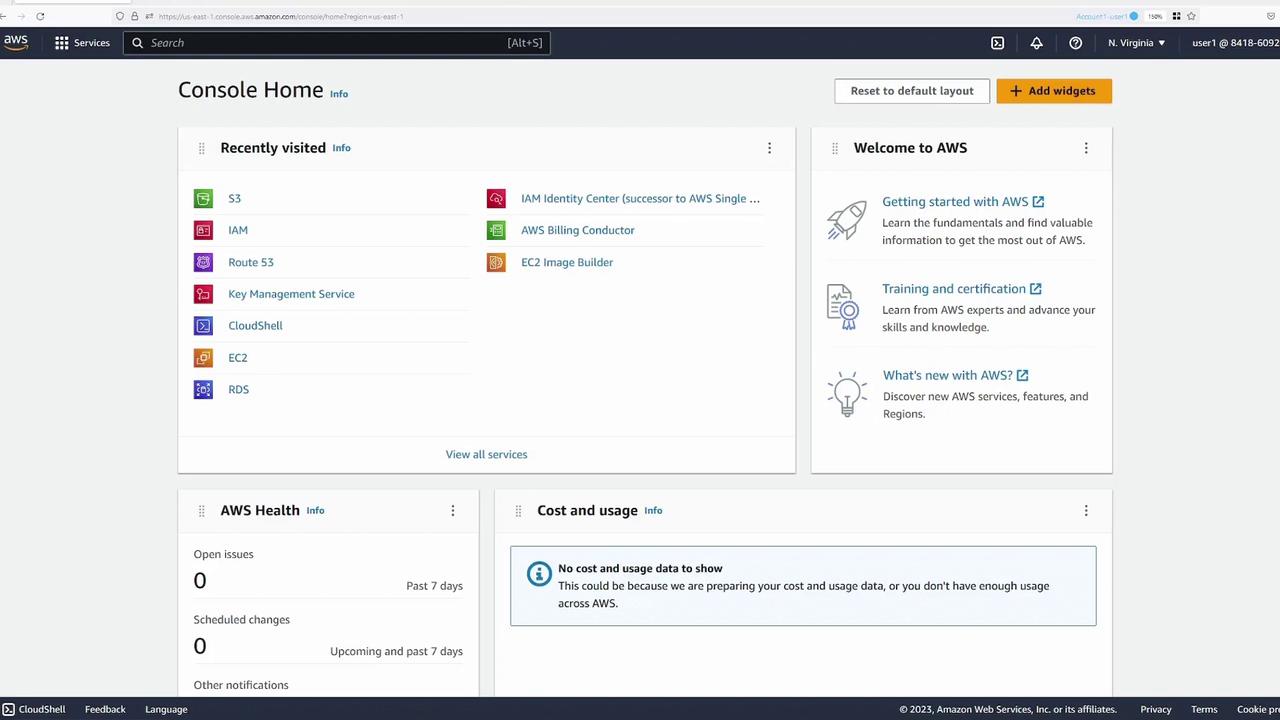
Creating the S3 Bucket
Using Account One, User One (blue tab), we create a demo S3 bucket with default settings. The configuration disables legacy NACLs, versioning remains off, and public access is blocked by default. Once the bucket is created, several files are uploaded.
Bucket Creation Process
Creating the Bucket:
A zoomed view of the bucket creation screen illustrates options for bucket name, region, object ownership, and public access settings.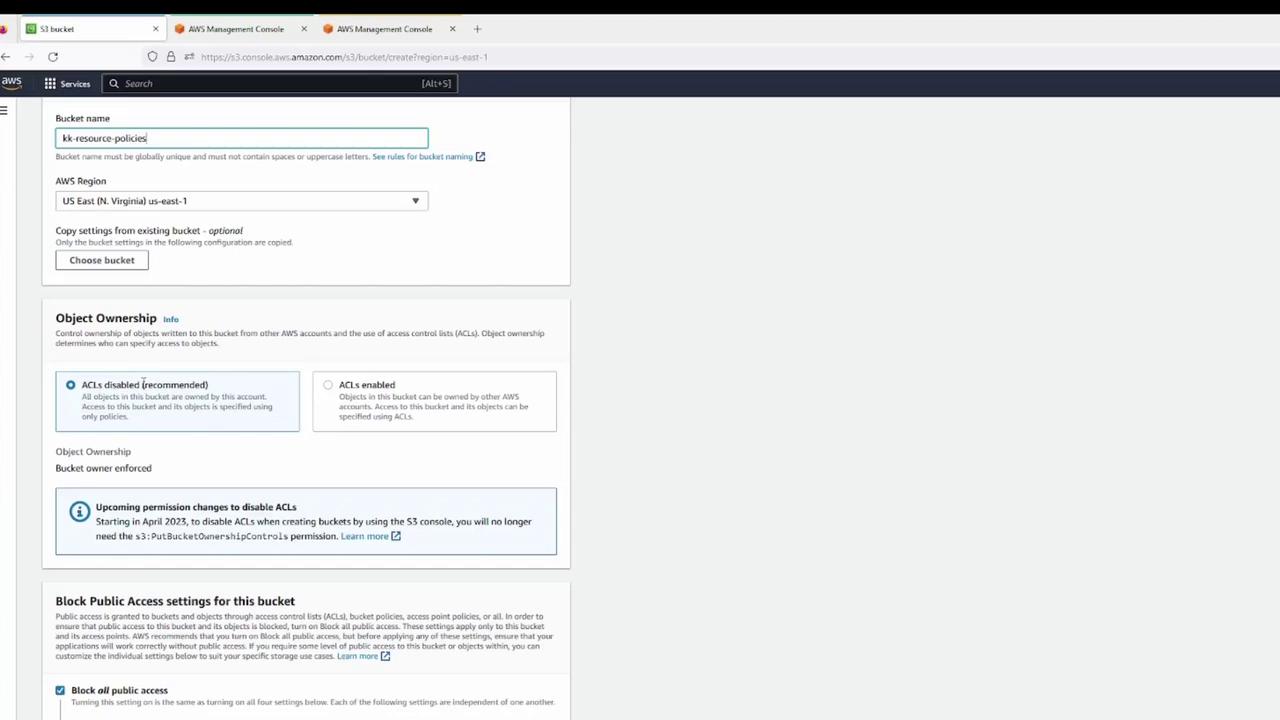
Post-creation and Upload:
After the bucket is created, you open it to upload files. The following image confirms the successful creation of a bucket named "kk-resource-policies" in the US East (N. Virginia) region, with the uploaded objects remaining non-public.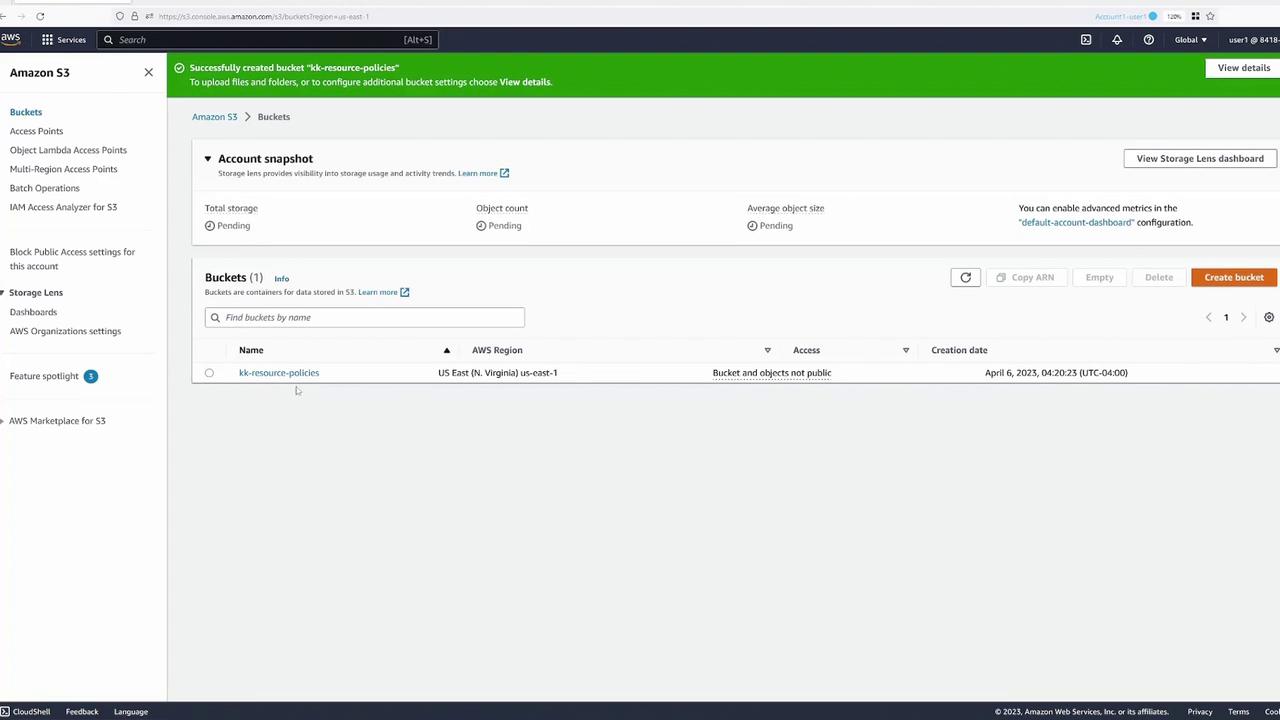
Verifying Access:
When accessing an object while authenticated as User One, permission is granted. However, accessing the object URL publicly results in an "Access Denied" error.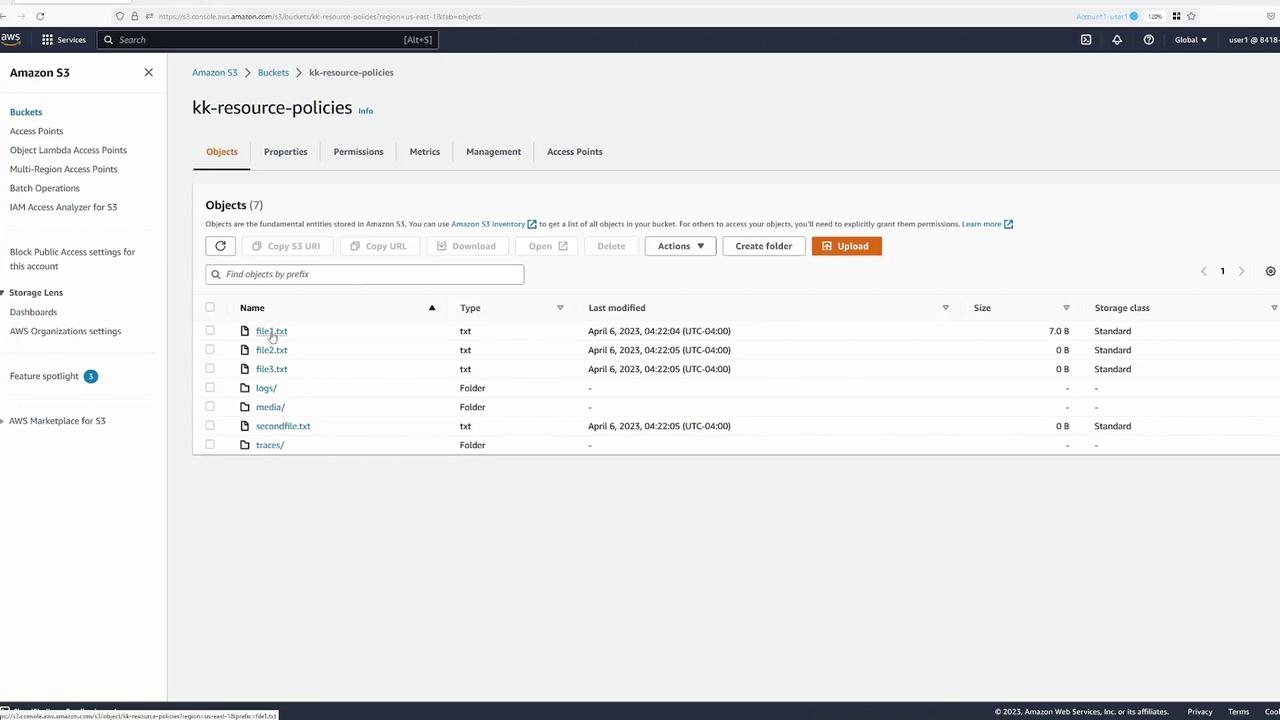
Testing IAM Policies for User Two
Before switching to User Two (green tab), we review the IAM policy assigned to User Two. The policy permits only listing of all buckets and bucket contents:
{
"Version": "2012-10-17",
"Statement": [
{
"Sid": "VisualEditor0",
"Effect": "Allow",
"Action": [
"s3:ListAllMyBuckets",
"s3:ListBucket"
],
"Resource": "*"
}
]
}
With this policy, User Two can view the bucket in the S3 console but cannot open objects directly. Trying to open a file (e.g., file1.txt) will trigger an "Access Denied" error.
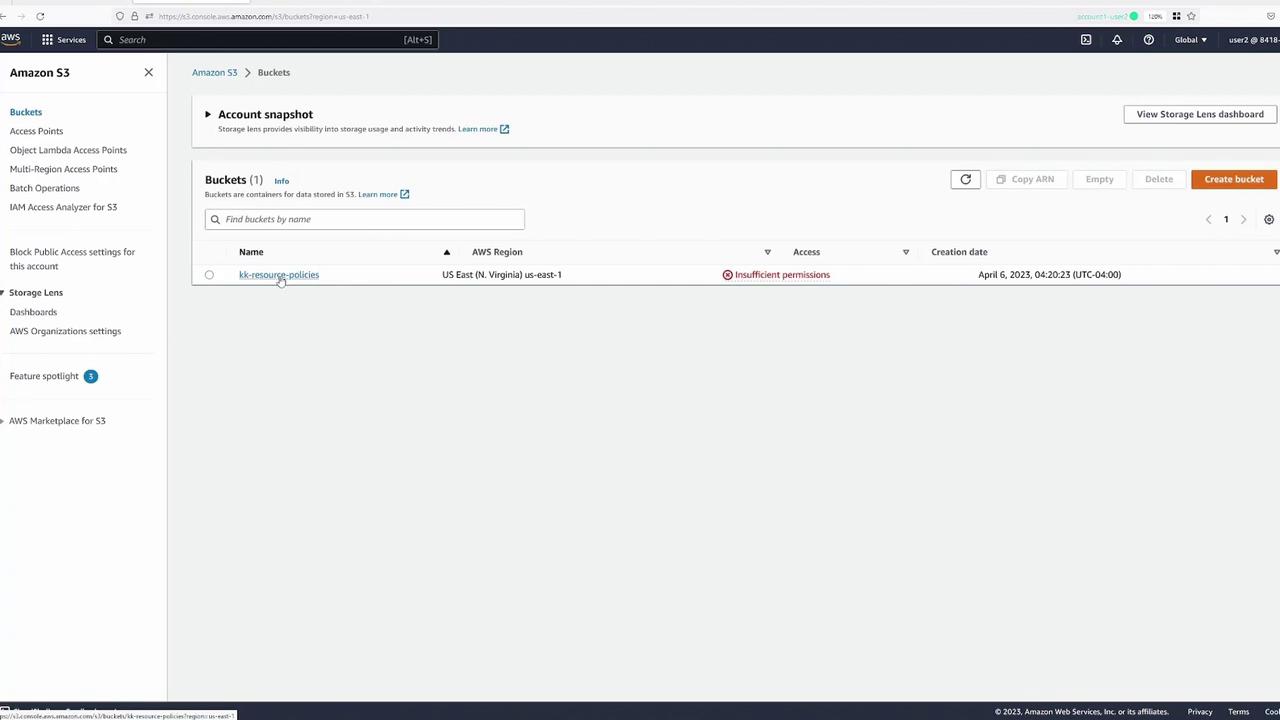
Creating a Resource Policy for Specific Folder Access
Returning to User One (blue tab), we now create a resource policy that permits User Two to access only the "logs" folder within the bucket.
Steps to Configure Folder-Specific Access
Modify the Bucket Policy:
Navigate to the Permissions tab of the bucket and edit the bucket policy using the AWS built-in wizard. Start with the default template shown below:{ "Version": "2012-10-17", "Statement": [ { "Sid": "Statement1", "Principal": {}, "Effect": "Allow", "Action": [], "Resource": [] } ] }Policy Implementation:
Name the policy "user2AllowLogs" and specify the principal using the AWS ARN for User Two. For example:{ "Version": "2012-10-17", "Statement": [ { "Sid": "user2AllowLogs", "Principal": { "AWS": ["arn:aws:iam::<ACCOUNT_NUMBER>:user/user2"] }, "Effect": "Allow", "Action": "s3:GetObject", "Resource": "arn:aws:s3:::kk-resource-policies/logs/*" } ] }Replace <ACCOUNT_NUMBER> with the actual account number.
Note
This resource policy grants GET access on all objects within the "logs" folder, ensuring that User Two can only view the content within that directory.
Verification:
After saving the policy, switch to User Two (green tab). Test by navigating to the "logs" folder and opening a log file; the file should download successfully. Attempting access to files outside this folder (e.g., file1.txt) will correctly result in "Access Denied."
For additional reference on S3 actions and resource policy construction, refer to the AWS S3 bucket policy documentation:
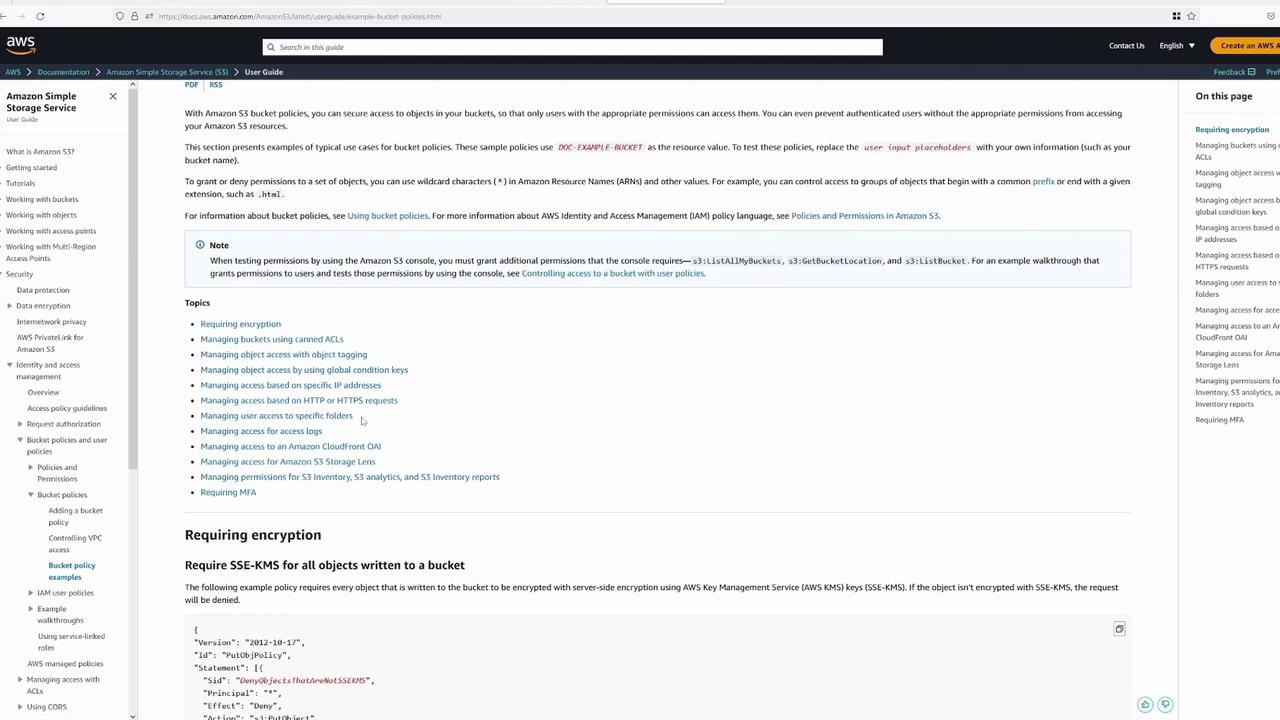
Granting Additional Permissions Using a Combined Policy
Next, we enhance the bucket policy to allow User Two the ability to delete objects from the "traces" folder, while maintaining GET access to the "logs" folder.
Updated Combined Policy
The revised bucket policy is as follows:
{
"Version": "2012-10-17",
"Statement": [
{
"Sid": "userAllowLogs",
"Effect": "Allow",
"Principal": {
"AWS": "arn:aws:iam::<ACCOUNT_NUMBER>:user/user2"
},
"Action": "s3:GetObject",
"Resource": "arn:aws:s3:::kk-resource-policies/logs/*"
},
{
"Sid": "user2AllowDelete",
"Effect": "Allow",
"Principal": {
"AWS": "arn:aws:iam::<ACCOUNT_NUMBER>:user/user2"
},
"Action": "s3:DeleteObject",
"Resource": "arn:aws:s3:::kk-resource-policies/traces/*"
}
]
}
Note
This configuration differentiates between GET and DELETE actions by applying them to specified folders using separate policy statements.
After applying this policy, when User Two attempts to delete an object in the "traces" folder (e.g., "trace1"), the deletion is successful, while deletion attempts in other folders are rejected.
Combining Permissions in a Single Statement
At times, you may wish to combine permissions for different resource types in a single statement. However, combining object-level operations (like "s3:GetObject") with bucket-level operations (like "s3:DeleteBucket") in one action can cause errors if applied incorrectly. To resolve this, list both resource ARNs in an array as demonstrated below:
{
"Version": "2012-10-17",
"Statement": [
{
"Sid": "user2AllObject",
"Effect": "Allow",
"Principal": {
"AWS": "arn:aws:iam::<ACCOUNT_NUMBER>:user/user2"
},
"Action": [
"s3:GetObject",
"s3:DeleteBucket"
],
"Resource": [
"arn:aws:s3:::kk-resource-policies",
"arn:aws:s3:::kk-resource-policies/*"
]
},
{
"Sid": "user2AllowDelete",
"Effect": "Allow",
"Principal": {
"AWS": "arn:aws:iam::<ACCOUNT_NUMBER>:user/user2"
},
"Action": "s3:DeleteObject",
"Resource": "arn:aws:s3:::kk-resource-policies/traces/*"
}
]
}
Warning
Ensure that actions are applied to the correct resource types by segregating bucket-level and object-level operations in your policies.
Allowing Public Access to Specific Folders
To demonstrate controlled public access, a policy statement is added that allows anonymous GET requests for a designated folder, such as "media." Before doing so, disable the "Block Public Access" feature for the bucket as required.
Public Access Policy Example
{
"Version": "2012-10-17",
"Statement": [
{
"Sid": "AllowPublic",
"Principal": "*",
"Effect": "Allow",
"Action": "s3:GetObject",
"Resource": "arn:aws:s3:::kk-resource-policies/media/*"
}
]
}
After the policy update, objects stored in the "media" folder become publicly accessible via their URL, while objects outside this folder continue to be restricted.
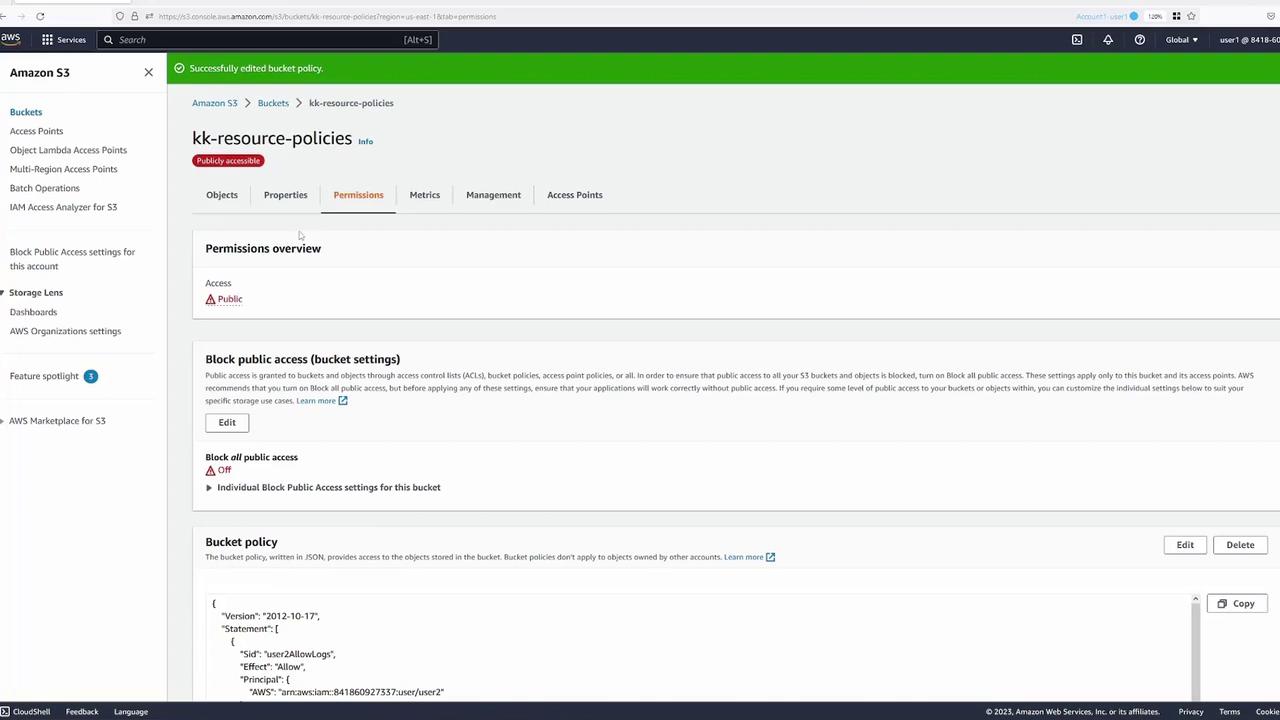
Granting Access to a User in a Different AWS Account
Finally, we demonstrate how to grant permissions to an external user (Account Two, yellow tab). Initially, when the external user attempts to list the bucket contents using Cloud Shell, the output is as follows:
[cloudshell-user@ip-10-6-180-191 ~]$ aws s3 ls s3://kk-resource-policies
An error occurred (AccessDenied) when calling the ListObjectsV2 operation: Access Denied
Updating the Bucket Policy for External Access
To allow access, we add new policy statements to permit Account Two's "admin" user the ability to list the bucket and delete objects from the "logs" folder. The updated policy snippet is:
{
"Version": "2012-10-17",
"Statement": [
{
"Sid": "AllowAccount2UserAdmin",
"Principal": {
"AWS": "arn:aws:iam::<ACCOUNT_TWO_NUMBER>:user/admin"
},
"Effect": "Allow",
"Action": "s3:ListBucket",
"Resource": "arn:aws:s3:::kk-resource-policies"
},
{
"Sid": "AllowAccount2UserAdminDelete",
"Principal": {
"AWS": "arn:aws:iam::<ACCOUNT_TWO_NUMBER>:user/admin"
},
"Effect": "Allow",
"Action": "s3:DeleteObject",
"Resource": "arn:aws:s3:::kk-resource-policies/logs/*"
}
]
}
Replace <ACCOUNT_TWO_NUMBER> with the appropriate account number.
After saving the change, the external user is able to list the bucket contents and delete objects within the "logs" folder. For example, a Cloud Shell session might display:
[cloudshell-user@ip-10-6-180-191 ~]$ aws s3 ls s3://kk-resource-policies
2023-04-06 08:22:04 PRE media/
2023-04-06 08:22:04 PRE traces/
2023-04-06 08:22:05 7 file1.txt
2023-04-06 08:22:05 0 file2.txt
2023-04-06 08:22:05 0 secondfile.txt
Deletion of files outside the permitted folder (e.g., file1.txt) remains restricted and will return an "Access Denied" error.
Conclusion
In this lesson, we demonstrated how to:
- Create an S3 bucket and upload objects.
- Use IAM policies to restrict a user's actions.
- Define granular resource policies to grant GET and DELETE access to specific folders.
- Implement public (anonymous) access for a subset of objects.
- Grant permissions to users in other AWS accounts.
By following these techniques, you can achieve flexible and secure access control for your S3 buckets while ensuring efficient resource management.
For more details, visit the AWS Documentation and explore further use cases for resource policies.
Watch Video
Watch video content